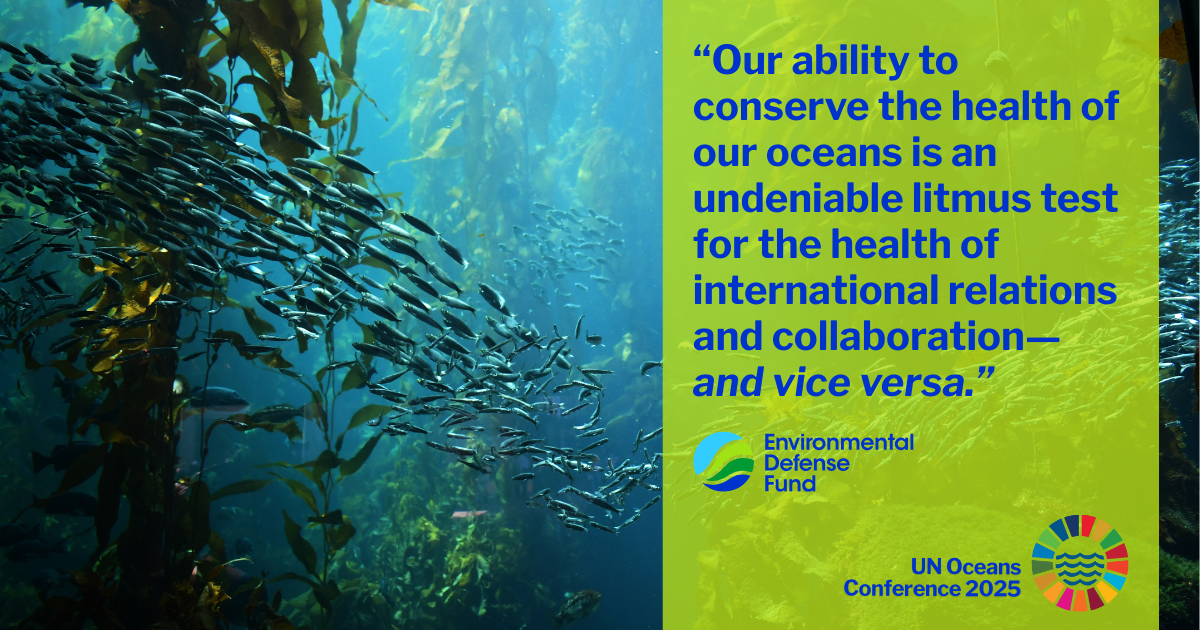New Study Supports Conservation Benefits of Catch Shares
 Rod Fujita, Ph.D
Rod Fujita, Ph.D
Director, Ocean Innovations
Environmental Defense Fund
A new study released today (Essington, 2009) supports the results of other studies showing the benefits of catch share management in fisheries (Costello et al., 2008; Heal and Schlenker 2008).
The paper looks for a response in biomass, exploitation rate, discards, effort, compliance with catch targets and landings in 15 North American catch share fisheries.
The paper did not find that these catch share fisheries, on average, reduced overall landings or that they increased biomass. That seems to be because most of these fisheries were not overfished–so the overall catch would not be expected to go down, and biomass would not be expected to increase, because these were not management goals. To test the hypothesis that catch shares can rebuild depleted populations, it will be important to analyze depleted fisheries, over rebuilding time frames. In this study, only one of the 8 fisheries that had explicit overfishing targets was substantially overfished.
The study did show that catch share fisheries moved landings, exploitation rates, and biomass levels closer to their targets, whether they were above or below the targets. Since some of the fisheries were above and some were below, these changes averaged out, resulting in small net changes. The exception was discard rate, which appears to have dropped by about 30% in the small number of fisheries examined.
While the results should not be over-interpreted due to the relatively small number of fisheries analyzed, the study’s finding that catch share fisheries reduce variation in landings, exploitation rates, discards, and compliance with catch targets suggests that catch shares improve the ability of fishery managers to achieve management goals – very good news indeed. If the goals are to reduce fishing to sustainable levels and rebuild depleted stocks, this study strongly suggests that catch shares will help managers reduce fishing mortality to sustainable levels and increase the biomass of depleted stocks. The paper documents the fact that before catch-share implementation 3 of the fisheries in the study had exploitation rates that exceeded the target rates, but after catch shares were in place, all of the fisheries had exploitation rates below the target rate.
The author used a rigorous methodology to examine these fisheries (before-and-after comparisons were complemented by comparisons within fisheries with non-catch share and catch share sectors, and with a meta-analysis). As more catch shares are implemented and a greater diversity of fisheries under catch shares are studied with such methods, I anticipate that the author’s observation that variance in management metrics is reduced by catch share management will be borne out. This will translate into improved rebuilding of depleted stocks, prevention of overfishing, reduction in bycatch and discard, and even a reduction in the effects of fishing on habitats – if the management targets themselves are robust.
A lot depends on the quality of the management goals and targets. But sustainable catch limits – by themselves – have been difficult to implement, especially when they are imposed on overfished or overcapitalized fisheries, because of the high social and economic impacts associated with cuts in allowable catch. Buyouts and other measures to mitigate these impacts have also been very difficult to implement, and seldom include conservation commitments or mechanisms to protect whatever conservation gains result. Catch shares can ease implementation and help managers achieve management targets, even when fisheries are overcapitalized or depleted.
Results from the new catch share program for Gulf of Mexico red snapper are instructive. The red snapper fishery there has been chronically overfished for decades; so the goal has been to stop overfishing and rebuild the stock. For the past three years the commercial sector has been fishing under a catch share program. NOAA announced in August that compliance rates are extremely high, that discards are down dramatically, and that stock recovery has been expedited. This fishery is quickly recovering due to success in lowering catch rates (a goal that was elusive prior to catch shares), and fishermen may see increased fishing limits (meaning more fish to catch) next year.
As more overfished fisheries transition to catch shares over the coming years (including New England groundfish and Pacific groundfish), I expect we’ll see that catch shares can and do help recover fish populations.
Literature Cited
Essington, T. 2009. Ecological indicators display reduced variation in North American catch share fisheries Proceedings of the National Academy of Sciences DOI: 10.1073/pnas.0907252107
Costello, C., S. Gaines, and J. Lynham 2008. Can catch shares prevent fisheries collapse? Science Vol. 321, pp. 1678-1682.
Heal, J. and W. Schlenker 2008. Sustainable fisheries. Nature, Vol. 455, pp. 1044-1045













5 Comments
This analysis confirms what many already believed – including the National Research Council – that catch shares are an economic allocation tool not a conservation tool.
This has been recognized for years, but EDF has continued to falsely push catch shares as an environmental tool. Some of the big green groups and intelligent people have fallen for this misrepresentation and thus have turned a blind eye to EDF’s blatant push for fishery privatization.
EDF, with the release of this paper:
Will you stop trying to dupe the public that catch share are a conservation tool?
Will you begin to talk about catch shares as an economic allocation tool?
Will you start to talk about resource rent capture to finance better ocean management?
Will you start to talk about a vision for U.S. fisheries?
Will you confess that you have been pushing the privatization catch share model exclusively?
Will you acknowledge that your backers desire a corporate takeover of the fishing industry?
Will you acknowledge that there are ways to design catch shares that benefit the public interest?
U.S. fish resources belong to the public. Catch shares are an economic tool to allocate the wealth from this public resource. EDF should get real on catch shares and stop the spin. Fingers crossed x
CONCLUSIONS FROM LENFEST
Essington’s analysis shows that North American fisheries primarily respond to implementation of catch share programs by becoming more predictable and consistent. He also demonstrated that catch share programs may not necessarily lead to higher stock levels and lower average exploitation rates; however, these results may depend on whether a fishery is significantly overexploited at the inception of the catch share program. Thus, he suggests catch share programs might best be viewed as one op-
tion for sustainable fisheries management within a suite of possible management tools, such as no-take marine reserves, ocean zoning and ecosystem based management.
It’s not EDF coming to the conclusion that catch shares are a critical conservation tool for sustainable fisheries; it’s the science. See the articles cited above as two examples:
Costello, C., S. Gaines, and J. Lynham 2008. Can catch shares prevent fisheries collapse? Science Vol. 321, pp. 1678-1682.
Heal, J. and W. Schlenker 2008. Sustainable fisheries. Nature, Vol. 455, pp. 1044-1045
The most significant finding in Essington’s paper is the effects of catch shares on dampening fluctuations in exploited fish stocks. This undoubtedly is an important conservation outcome. Large swings that move the stock to very low sizes at times introduce the risk of becoming trapped in a depleted state by a number of ecological, demographic and genetic barriers to recovery (Hsieh et al. 2006). Empirical evidence shows how difficult recovery from these valleys in abundance can be (Hutchings and Reynolds 2004). Management systems that increase ecological resilience and reduce vulnerability to such a depressed and perhaps inescapable situation are critical conservation tools (Scheffer et al. 2001). Essington’s paper shows that catch shares help create that needed resilience.
Dampening fluctuations can also create important benefits for the fishing industry by increasing stability and predictability. Being more confident in the likely status of the stock in the years ahead enables better planning. Of course, fish stocks and the ecosystems of which they are part will never be completely predictable, especially in the face of a changing climate. But any management system that reduces uncertainty can help offset the inherent stochasticity and larger climactic changes fishermen will inevitably confront.
These dual benefits of catch shares further illustrate the core strength of this approach to management. Creating a dichotomy between “economic tools” and “conservation tools” is unnecessary, and in fact counter-productive. Tools that work to align social, economic and ecological goals offer our best hope of eliminating conflicts between these goals and best serving the broader public interest.
That the public interest will be served is ensured by the inescapable reality that catch shares do not mean privatization, at least under U.S. law. Catch shares are an access privilege accompanied by performance standards and accountability (e.g., monitoring, penalties). It is a way of the larger public creating and empowering a more stable industry, serving as stewards, that can generate economic activity, provide healthy food, and support coastal communities, all while preserving other ecosystem services and simple existence value of our nation’s natural resources.
Finally, I urge all stakeholders in our fishery resources to have a look at the Catch Share Design Manual (http://www.edf.org/page.cfm?tagID=47273). This comprehensive guide book clearly illustrates that there are a wide range of possible goals for a fishery (ecological, economic and social), and an equally wide range of approaches to meet those. Simplistic views of catch shares as a single “thing” miss the diversity and adaptability of the concept, and experience shows how catch shares can be tailored to work well with ecological and social conditions (e.g., Gonzalez et al. 2006).
Literature cited
González, J. W. Stotz, J. Garrido, J.M. Orensanz, A.M. Parma, C. Tapia and A. Zuleta. 2006. The Chilean TURF system: how is it performing in the case of the loco fishery? Bulletin of Marine Science, vol. 78, pp. 499-527.
Hsieh, C.H., C.S. Reiss, J.R. Hunter, J.R. Beddington, R.M. May and G. Sugihara. 2006. Fishing elevates variability in the abundance of exploited species. Nature, vol. 443, pp. 859-62.
Hutchings, JA and J.D. Reynolds. 2004. Marine fish population collapses: consequences for recovery and extinction risk. Bioscience, vol. 54, pp. 297-309.
Scheffer, M, S. Carpenter, J.A. Foley, C. Folke and B. Walker. 2001. Catastrophic shifts in ecosystems. Nature, vol. 413, pp. 591-596.
There are many fatal flaws in the EDF spin on fisheries management. I agree owner’s are more prone to be better stewards, but Catch Shares is not about fishermen ending up with the resources. ITQ (catch shares) holders end up being non-fishermen & many cases non-residents. This throws out the better stewards point.
There is not one reason to privatize a public resource. It is obvious, you know little about fishery management & a lot about BS. You can fool some of the people all of the time,you can fool all of the people some of the time but you can’t fool all of the people all of the time.
Your “scientific” papers are bought. No one gives them any credence.
Why does EDF endorse catch shares, which end up in the hands of huge factory ships which are detrimental to our ocean’s environment. The answer is easy, you are about investment, hiding under a green cloak.
Science bought and paid for by none other than Packard for EDF via NCEAS, Stanford and UC-SB to the tune of 9 million dollars for Drs Costello and Gaines to conceptualize the theory behind catch shares- Since when does .04% of anything (the amount of overall catch share fisheries studied of over 10,000 fisheries world-wide) qualify as science?
News flash- Just because you pay (and well) for the science, it still doesn’t mean it’s true. You can spin it, and EDF spins well, but truth cannot be bought.